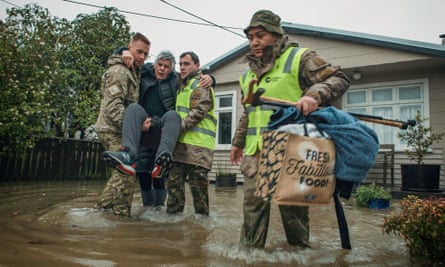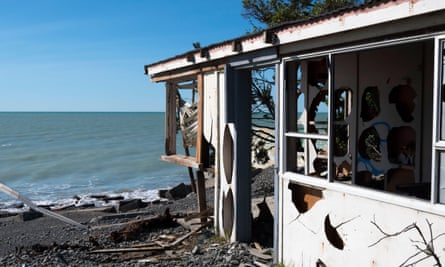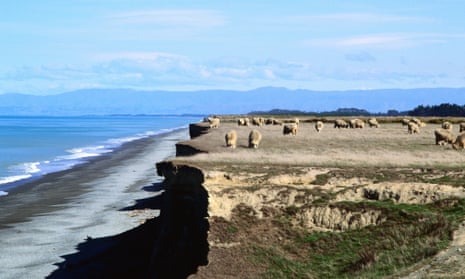The tiny settlement of Westport is no stranger to a deluge – the oldest European settlement in the South Island sits on New Zealand’s West Coast, which holds the unenviable gong for the highest annual rainfall in the country. It is also familiar with floods. The community of fewer than 5,000 people perches on the low lying banks of the Buller River – a broad, temperamental waterway that bottlenecks out to the Tasman sea.
In 1926 the river broke its banks and flooded the town, causing widespread devastation. There have been numerous floods since, but until this year, it had escaped catastrophe with the implementation of a man-made overflow channel into the Orowaiti River, regular dredging and river training walls.
But, on 15 July this year, torrential rain set in and did not stop for three days. The region recorded 700mm of rain – a month’s worth – in 72 hours. The subsequent flooding rendered around 70 homes unliveable, another 400 in need of serious repair, and caused significant damage to infrastructure and farming.

The outlook for places like Westport is not good and begs the question, do they rebuild or relocate?
“These are very challenging and confronting conversations you have with homeowners. In a way you get a bit of an NZ attitude ‘she’ll be right’ when long term, she won’t be right,” says Stuart Crosby, president of Local Government New Zealand (LGNZ) .
Westport is an area predisposed to flooding but the flooding’s regularity is being exacerbated by extreme weather, and its disastrous effects are being intensified by sea level rise, both brought on by human activity.
The risk of litigation
It is not the only town that will have to grapple with the question of managed retreat in the coming years. As of 2019, roughly 72,000 people in New Zealand are exposed to coastal flooding – about 50,000 homes worth at least $12.5 bn. Around 43,000 Auckland residents are directly threatened by rising sea levels, and at least 10,000 houses across New Zealand’s four major coastal cities are at risk of becoming uninsurable within the next 30 years.
LGNZ estimates the amount of local infrastructure exposed to sea level rise to be in the realm of $14 bn, but adds that that is a conservative estimate.
The burden and complexities of managing exposure to sea level rise and other extreme weather has predominantly fallen on to regional councils, with few central government frameworks to draw upon.

“Councils are on the frontline in the fight against climate change and we have been calling on successive governments to develop an adaptation framework for some time,” says Crosby.
Not only are councils having to take an ad hoc approach to managing crises as they arise, but trying to prevent future crises opens them up to litigation from developers and wealthy property-owners.
Through trying to include hazard information on Land Information Memorandums – a public property summary – they have faced costly court action from property owners who fear it will diminish the value of their land.
Crosby said the lack of a standard framework limits councils and said there is “no way councils on their own can support communities through adaptation”.
He said while the government is starting to take the problem seriously, he is concerned that the focus will be too heavily placed on stopping future developments and not creating a process for existing communities.
“It’s been a conversation that’s taken a lot of time and frankly we need to speed it up and create some certainty for the councils.”
Climate leases on properties?
When Belinda Storey, a climate change economist and expert in coastal erosion insurance, walks along Cooks Beach in the Coromandel, she despairs.

“There is a house, where the walkway in front of the house has been washed away, and they are currently building a great big house. It’s all along the beach front – these massive houses are being built and the land is eroding.”
When Storey has held workshops for communities on sea level rise, people frequently suggested creating a public insurer, which, she adds, would only incentivise further development in risky locations.
Storey also dismisses solutions that rely on seawalls or stop-banks, saying that can lead to erosion in other areas as the water is pushed to the side, and that it is just kicking the can down the road.
She says if people build in coastal areas, it should come with limitations, in the form of a climate lease. That would mean there is a time-stamp on the property to say it can only be used for the next, say, 40 or 100 years, depending on the risk to the site.
“At the moment, people are building and they either don’t believe sea level rise is going to happen, or they assume if something happens, someone will step in,” Storey said.
“In a way they are right – international evidence strongly shows that in a disaster when a house gets damaged, the government finds it almost impossible not to step in.”
But this is the wrong approach, she said.
Ultimately, the obligation must shift onto would-be homeowners to demonstrate that their new-build will be safe for 100 years, rather than requiring the local government to prove it is not, Storey said.
It will not just be government regulation that discourages development in the coming years, she said. First there will be insurance retreat, which will then lead to bank loan retreat, then there will be infrastructure retreat as the cost of repairs continues.
“Retreat sometimes happens well before the land disappears.”
No ‘one-size-fits-all approach’
Earlier this year the government announced it would reform the Resource Management Act (RMA) – a huge, outdated and nebulous piece of legislation that has turned into something of a Frankenstein’s monster, with upwards of 20 amendments made since it was introduced in 1991.
The RMA will be replaced with three new pieces of legislation – a natural building law, a strategic building law and a climate adaptation law. The first two pieces are well under way, but little yet is known what the third, which will deal with issues of managed retreat and natural hazards, will look like.
The environment and resource management act (RMA) spokesperson for the opposition National party, Scott Simpson, worries that the last piece of legislation will not be introduced this term and that no one has any cognisance of what its parameters will be.
Creating a framework to address the fraught challenges that arise with questions of managed retreat – particularly that of who pays – may take time, and there is serious risk of doing more harm than good if it is structured poorly.
James Shaw, the minister for climate change, who is set to attend the Cop26 climate change summit next week, said that examples of extreme weather and coastal flooding affecting towns such as Westport and Matatā in the Coromandel are the canaries in the coalmine for what is to come.
“New Zealanders are complacent, but through no fault of their own,” he said.
In parts of Europe, and in countries like Australia and the US, where there have been “biblical firestorms” and heatwaves, people have very real lived experience of the changing climate.

“New Zealand has been lucky in that in the particular nature of climate, we haven’t experienced extreme events in the same frequency or severity, so haven’t made a connection between flooding and climate change.”
But that’s changing, he noted.
He sympathised with councils who have been “poking the central government in the ribs for many years” on the issue of needing greater support and frameworks, adding that previous government’s have not been nimble enough in dealing with the problem.
The RMA reforms are designed to do this, he said, and will include ensuring there is no ‘one-size-fits-all approach’.
He intends for the bill on climate adaptation to be introduced before the end of the government’s term in 2023.
The fraught issue of ‘who pays’ when a community faces retreat will “undoubtedly” cause tensions, Shaw said, adding that not every loss will be covered.
“Conversations are happening at cabinet level around fairness and ensuring people who are already vulnerable, in a sociological sense, are not further disadvantaged by transition.
“Because the issues are so contentious and the risk of having gross inequities in the outcomes is so high, it’s really important that we get it right.”

Comments (…)
Sign in or create your Guardian account to join the discussion